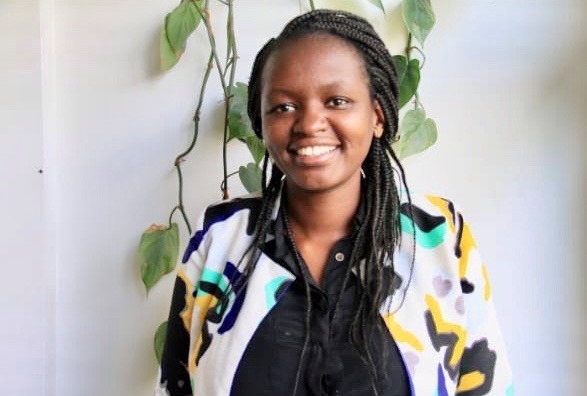Welcome to part one of our February 2020 Inspirational Interview with Kathomi Gatwiri, co-founder of Counting Dead Women – Kenya, a Facebook page that records every woman’s murder reported in the Kenyan media.
Dr Gatwiri is an African-Australian academic and trauma researcher and the author of African Womanhood and Incontinent Bodies. She is also a senior lecturer teaching social work and social policy at Southern Cross University in Australia. In 2017, Dr. Gatwiri was named “Young Kenyan of the Year” and in 2019 was awarded the “Early career research” award for her excellence in research on childbirth trauma amongst African women.
Part 2 of the interview will be published on Monday, February 24, 2020.
Photos courtesy of Kathomi Gatwiri.

1. How and why did you join the movement to end violence against women?
As a woman living in the world as it is now, to not be in a movement that aims to end violence against women is actively choosing not to be on your own side. I think a lot of women who are engaged in this work have experienced some version of gender-based violence themselves or seen it happen to women they love. When you are surrounded by any kind of violence, it’s so easy for it to feel omnipotent, all-consuming, and all-powerful because of the sheer magnitude of it.
Growing up in Kenya, I observed how this violence broke and fragmented my grandmother, and eventually cost the life of my mother’s sister. My desire to end all forms of violence against women is for all women- like my cucu and my aunty- but it is also for me. I want to be able to walk home alone at night. I want to know that I will not be killed if I piss a man off. I want to know that my female body does not attract violence simply by existing. I am also curious to see how differently women would choose to live their lives if those choices were not often dictated by self-preservation and safety. Plus, wouldn’t it just be nice for this not to be a conversation that’s necessary?
2. How and why did you and co-founder Audrey Mugeni start building the Counting Dead Women – Kenya (CDW-K) database?
Audrey Mugeni and I started Counting Dead Women – Kenya (CDW-K) in January 2019. We had two aims:
- First, to bring to the attention of legislators the number of women who die through acts of violence every day in Kenya. We hoped that when they saw these numbers, they would treat the issue of gender-based violence (GBV) as a national crisis and move swiftly into action through developing laws and policies that not only protect women, but also address the core issues underpinning men’s violence against women.
- Our second aim was for it to be a call-to-action for the government to create a national database that records the numbers of women who are killed through violence. Right now the issue of GBV is often easily dismissed because there is no concrete data to inform the evidence base. We believe that with numbers and statistics on our side, we will be able to prove beyond any reasonable doubt that violence against women in Kenya is an issue that justifies a government and legislative response.
3. We have interviewed activists like Elizabeth Wilcox and Annita Lucchesi who discussed the particular challenges they have faced in building their databases – for Ms. Wilcox it is the huge population size of the USA and for Ms. Lucchesi, it is the difficulty of accessing data on the numbers of murdered and missing indigenous women. What are the specific challenges that the CDW-K team has to deal with when counting femicides in Kenya?
Ours is not a database yet – it is a Facebook platform that records the deaths of women that are caused by violence, as reported by the local dailies and newspapers. Our biggest challenge is that we are potentially missing many other women living in the remote villages or urban slums and whose stories will never be captured in the media. We are not resourced enough to do everything to close these gaps and this is the best we can do at the moment.
There is also the challenge of vicarious trauma. In the last year, Audrey and I have had to be very deliberate about how many of these gory stories we could consume. We had to be intentional about looking after ourselves and each other. To read through the stories of hundreds of women like you, being murdered for the most nonsensical reasons, brings you very close to the reality of how violent and fragile the patriarchy and the misogyny it produces can get.
4. What are a few of the major patterns in violence against Kenyan women that you are seeing as the CDW-K database grows and are there any surprising ones?
From what we have observed in the last year, most violence is perpetrated by men towards women they are in intimate relationships with. The other significant number is of women who are killed by men they reject. The story of Ivy, a final year medical student comes to mind. Ivy’s killer travelled hundreds of kilometers with an axe and hacked her to death, in broad daylight, simply because she did not respond to his text messages.
It is important to note, however, that most women are killed by men they know, not necessarily strangers, although that’s a pattern on its own too.
5. In your opinion, what are some of the particular challenges that Kenya faces when tackling violence against women and how does the CDW-K database fit into efforts to do so?
Kenya is still very much dominated by very powerful patriarchal and religious ideologies that dictate the lives of women from when they are little girls. A lot of people use these ideologies to attach value to a woman’s life. For example, if a woman is killed by her husband, the conversation is often dominated by “whether she was a good wife” and “what she did to provoke him” rather than focusing on the husband who killed her. If a young university girl is raped and killed on the street, questions will be raised around what she was wearing, if she was drunk and who she was with. It implies that a woman only deserves safety if she performs “good womanhood.” But even then, being the “good girl” cannot guarantee safety because it’s not about that; it’s about how those who enact this violence exert power and control over them.
Women are constantly blamed for not being safe in an environment where every space is a potential death trap. Kenyan women are not safe on the streets, in their own homes, in school, in church, in the workplace, in public transport, in the hospitals–basically everywhere. So it begs the question, what spaces should women occupy so that they are not accused of “bringing it onto themselves?”
